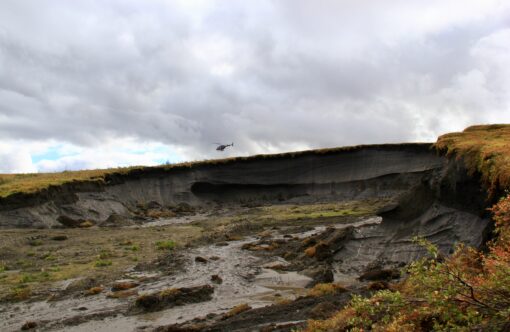Sliding between current and projected permafrost coverage (dark) shows the extent of loss (light) due to climate warming. Note the massive loss of permafrost when human carbon emissions are unmitigated. Derived from Karjalainen et al. (2019).
The Arctic is warming at three times the global rate, transforming the region, and threatening both Arctic communities and our global climate. The consequences of this rapid warming are—and will increasingly be—catastrophic, as rising temperatures accelerate one of the world’s most significant climate threats: thawing Arctic permafrost.
Permafrost is perennially frozen ground that, as it thaws, is causing the land to collapse, creating an environmental justice crisis for Arctic residents whose homes, villages, and ways of living are at risk. It also can release unaccounted-for amounts of greenhouse gasses back into our atmosphere.

Carbon emissions from permafrost thaw are expected to be anywhere from 30 to more than 150 billion tons of carbon by 2100 (110 to more than 550 Gt CO2)—with upper estimates on par with cumulative emissions from the entire United States at its current rate.
Yet, due to monitoring and modeling gaps, these emissions are largely omitted from today’s global carbon budgets and international climate policy, which is resulting in a severe miscalculation of how aggressively we must pursue emissions reductions, and what actions we can and must take to adapt.

To avoid irrevocable harm from permafrost thaw, it is essential that we incorporate what we already know about permafrost emissions into our global carbon budgets, and dramatically improve monitoring and modeling of thaw processes to inform strategies that can help us address the threats.
The decisions we make over the next decade can make a difference. But we must act now.
Our strategy3.6 Million
People live in areas at risk of infrastructure damage from permafrost thaw
Adaptation StrategiesProject News + Updates

- In the News
NOAA’s 2024 Arctic Report Card Says Tundra is Now a Net Source of Carbon to the Atmosphere

- Features
Northern communities adapt to a new era of Arctic-boreal wildfire

- In the News


